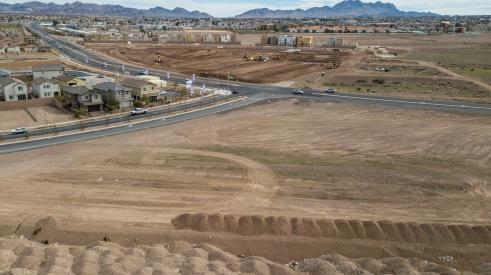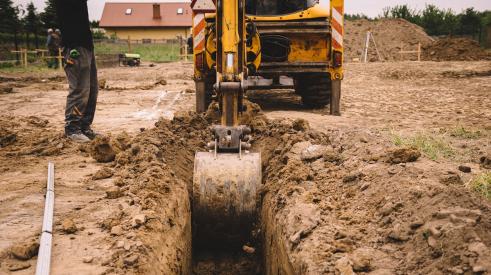|
|
|
|
|
|
|
|
|
|
|
|
Builder Tom Stephani of William Thomas Homes Inc. in Crystal Lake, Ill., walked, rode and drove past a 8.5-acre parcel of land for most of his life before the idea to build homes on it occurred to him in 1997.
He credits his dog for actually leading him onto the wooded, overgrown property just off his hometown's main street. Once on the property, Stephani grasped its size and potential.
Within close walking distance of a quaint area with thriving shops and restaurants, the parcel offered the opportunity for a small traditional neighborhood with home designs similar to ones built nearby in the early 1900s.
Flash forward to 2003, and Stephani and his firm oversee the final build-out of a sold-out, 23-unit, single-family detached community. Called Dole Crossing, the project realized profits well in excess of the original pro formas.
"I was very comfortable that there was a demand for new homes in downtown Crystal Lake," Stephani says. "I also knew there was a demand for this vintage look. The thing that we really blew it on was price point. We felt originally that these homes would be in the $135,000 to $225,000 price range, and we were so far off of that that it is almost embarrassing. We got almost double that price."
But underestimating future price points was icing on the cake compared with the underlying deal Stephani negotiated to purchase the land. Stephani's firm entered into a partnership with the landowner whereby William Thomas Homes took down finished lots only after a sale and just before pouring the foundation. The company had firm control of both the land and the process to develop it long before it acquired the property. This saved the company a large initial cash investment and considerable land-carry costs as the project earned approvals and permits.
The lesson that Dole Crossing and thousands of other similarly negotiated land purchase agreements offer other builders is that persistence and creativity pay, even in a generally overheated market for land.
A Cash-for-Land Environment
The continued strength of the housing market means fewer deals come down the pike from a builder's established network of land brokers. The deals they see tend to be margin busters, priced so high that slim profits limit the upside potential or make the site unworkable altogether. At the same time, bigger fish upstream now pay premiums - in cash - for those same finished lots. Even "blue-topped" lots (mapped and graded but without site improvements) draw a stream of cash buyers. Most builders simply can't afford to play this cash-for-land game.
"Any project with more than 10 or 20 lots becomes the object of a bidding war and a beauty contest," says residential developer Len Forkas, chairman of the Washington District Council of the Urban Land Institute and a principal with Milestone Communities in Reston, Va. "If the landowner is not naïve, they hold an auction. All the builders come, buy it and close within 30 days."
Ben Anderson, immediate past president of the Building Industry Association of Southern California and owner of BCA Development in Newport Beach, Calif., agrees. "The small and medium-size builder's strength is not to show up with a checkbook and compete against the big guys for land," he says.
Still, many builders defy these land supply issues every day. In all types of markets, they not only manage to keep a good inventory of "A" location lots in front of their home building operations, but they do so with greater profit and little or no upfront cash. They do it by controlling land without owning it.
Let's Make a Deal
Stephani says that for every land seller there is a different way to control land without owning it. He's talking about the nuances, the give and take and the details that make every land control deal unique. Areas of commonality, however, abound. In interviews with dozens of builders around the country, basic steps emerged.
1. The builder-developer identifies a piece of land that could be right for the kind of product he or she builds.
Many builders stress that this step requires equal parts creativity and sobriety. Valuable time can slip away chasing deals that go beyond a builder's core home building competency. Builders with clearly defined markets and core competencies - starter homes, attached move-up, luxury single-family detached, whatever those competencies might be - stand the best chance of knowing if their product will succeed on a site, several builders say.
A repeated theme: The best sites never make it to market. A builder should focus on being proactive rather than reactive. Many sites suitable for controlling without owning need lengthy entitlement work, which the builder can pursue while the owner continues to hold it. Such parcels frequently need rezoning. This basic level of information needs to be ascertained before contacting the landowner. Public records need to be sourced in person at municipal offices or, increasingly, online.
In today's market, residential sites of any type do not stay on the market long. Residential parcels that do stay on the market typically have costly liabilities to address. Our group of land-control-oriented builders keep an open mind about these issues. Potential problems include environmental hazard cleanups from previous uses; unclear title; easements; and ongoing litigation. More common, the site simply might contain natural features such as rocks or hillsides that render some types of development prohibitively expensive.
2. The builder/developer approaches the landowner with a proposal to build a residential project on the site.
The more specific the plan and the more detailed the vision for the property, the more compelling the opportunity will seem for the landowner. The vision should conservatively spell out the potential yield in dollars for the proposed project as a whole. The landowner must see clearly that the price he or she ultimately receives for the parcel will be based not on current market values but on a future yield the builder can deliver. This sweetens a potential deal significantly, especially for landowners who have held the property for a long time and have no pressing need to sell.
A key part of this step involves letting the landowner know that to realize the highest potential price for the property, he or she must wait until the builder receives some certainty that the project will be approved. In return, the land-owner enters into one of a number of legal arrangements to get the ball rolling. The most commonly used legal agreements include:
- straightforward purchase contracts with time lines for approvals backed by escape clauses underpinning the when and how a parcel eventually will be sold to the builder.
- a simple right of first refusal that may be the precursor to a purchase contract with all timing issues spelled out.
- an option agreement might give the builder all the confidence he or she needs to invest time into the property to seek entitlements.
Real estate attorney Mathew A. Wyman with Cox, Castle & Nicholson LLP in Los Angeles defines these and several other land control agreements in the glossary on page 51. He says these agreements compose only the basis for tailor-made documents that best reflect the risk tolerances of each party. Builders should not proceed far into a process with only a letter of intent, Wyman advises. Letters of intent simply map out the process by which a more binding agreement can be made.
3. The discussion then turns to tentative roles and responsibilities of the buyer and the seller.
Before the ball gets rolling, a basic structure of the relationship between the builder/developer and the landowner needs to be agreed to in principle. What the builder invests in most deals is sweat equity and ancillary costs related to securing entitlements. The seller's principal role in a land-control deal is to keep the land off the market until it can be purchased outright or taken down in smaller chunks by the builder. The seller accepts the opportunity cost of waiting and trusting that the deal will come to fruition. But other, more active roles for the seller often enter into the equation.
The seller sometimes can be actively involved as a partner in the project, sharing in the profits on a lot-by-lot basis as homes get sold, built and closed. Or the seller can choose a middle route and assume substantial risk without becoming a full partner by subordinating his or her title to a lending institution to provide development funds after the entitlements get secured but before any or all of the land gets taken down. The salient point here is the breadth of options for seller involvement: Joint ventures and partnerships are up to each party's discretion. The more options a builder presents to a seller, the more likely the builder will get his or her desired outcome.
4. Coming to a preliminary agreement typically involves trade-offs of risk and profit for both parties.
If a landowner finds the vision for the proposed project particularly appealing and is confident in a builder/developer's ability to deliver a successful project from start to finish, the landowner might be open to accepting more risk. This gives the builder/developer the luxury of picking a level of investment in the property. If the builder/developer allows the landowner in on the deal as a partner, the land can collateralize acquisition and development notes.
A landowner less confident in the builder/developer's vision and the property's future yield might decide to seek a nonrefundable deposit before entering a deal in which the landowner holds the property until there is a tentative map with a unit count. At that point it would be up to the builder to take down the entire property, using the land as collateral. Because the builder assumes more risk in this scenario, the purchase price will be negotiated down.
Anderson says most sellers don't want to be involved beyond a tentative map stage. The added returns don't justify the risk. Their biggest worry, he says, stems less from whether a project will succeed than how quickly the builder will deliver a tentative map.
"They might ask that $100,000 be put in escrow as part of the agreement," Anderson says, "just to make sure you will pay attention to the project."
5. Detail the finer points and write up the agreement.
Local entitlement realities dictate much of the timing spelled out in any agreement that will result in land acquisition for development. Getting a parcel re-zoned and putting an approved map in place, with densities specified, generally requires a year to 18 months in most places. But this time line can run much longer in states such as California and New Jersey where development bureaucracies tend to draw out approvals over many years. A point stressed continually by builders who successfully control land without owning it is the importance of entering only agreements that allow enough time for entitlements to be won before land must be taken down.
If a purchase contract is contingent on tentative map approval, many builders see to it that the contract allows 90 or 120 days for acquisition financing to be arranged after the map is approved. Builders also stress that even when deadlines pass, landowners typically reward diligent progress with a renegotiated time frame. A landowner might be less inclined to do so if a builder's recalcitrance can be blamed for entitlement delays. At that point, the landowner might let a deal lapse at a builder's considerable expense.
Most agreements include a feasibility period of 30 to 120 days. This gives the builder/developer time to do intensive due diligence on all aspects of the parcel. If this process uncovers a significant problem, the builder/developer can walk away or renegotiate.
Advertisement
Related Stories
Land Planning
Helena Habitat for Humanity Aims to Build 1,000 Affordable Homes
A new Habitat for Humanity project in Helena, Mont., aims to deliver 1,000 affordable housing units and outdoor community amenities
Government + Policy
How Eminent Domain May Be Used to Respond to Climate Crises
Eminent domain, which grants the government power to take private property for public use, has displaced thousands of Americans for the sake of infrastructure in the past, but it may be used for a better purpose in a global climate crisis
Q+A
Soil Connect Is Moving Dirt and Building Relationships
Cliff Fetner created Soil Connect so builders and developers could more easily move dirt and other aggregates from jobsite to jobsite, but it has expanded to become something much more






